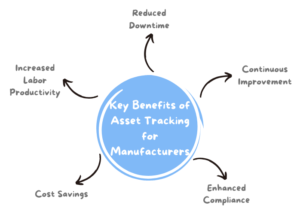Introduction
Imagine a critical machine idling because a necessary tool vanished from the shop floor. Such scenarios plague many factories, causing delays, idle labor, and missed production targets. Shockingly, workers spend up to 47% of their time simply locating tools—wasted productivity directly impacting profits. Manufacturing asset tracking solutions eliminate these costly disruptions, transforming operations from chaotic to efficient, lean production. These solutions are part of a broader asset tracking ecosystem used across industries. To understand how asset tracking works and why it’s essential, explore our comprehensive guide on Asset Tracking: The Ultimate Guide for Finance, IT, and Operations.
Learn how modern asset tracking can save hours and dollars on your factory floor
Learn how modern asset tracking can save hours and dollars on your factory floor
The Hidden Costs of Not Tracking Assets
-
Downtime and Lost Productivity
Untracked assets cause unplanned downtime, costing manufacturers around $260,000 per hour on average. Even brief searches significantly affect output and profitability. Every minute spent locating missing tools reduces valuable production time and productivity.
-
Labor Inefficiencies
Without effective asset tracking, skilled workers spend excessive time searching rather than working. Studies reveal 1 in 3 businesses poorly track tools, causing valuable staff to become de facto search teams. This inefficiency substantially inflates hidden labor costs.
-
Duplicate Purchases and Asset Loss
Manufacturers frequently purchase additional equipment “just in case” when visibility is lacking. For example, the North American auto industry spends around $750 million annually replacing lost reusable containers and pallets (Source: opentext.com). Effective asset tracking prevents these unnecessary expenses by providing real-time visibility.
-
Safety and Compliance Risks
Untracked safety gear or misplaced tools compromise safety protocols and compliance. For instance, losing a calibrated torque wrench can result in production continuing with uncalibrated tools, risking product quality and regulatory fines. Asset tracking safeguards against these avoidable risks.
-
Employee Morale
Constantly hunting for missing equipment frustrates employees, potentially increasing turnover. With skilled labor shortages, reducing worker frustration through asset tracking becomes increasingly valuable.
Implementing Asset Tracking in Manufacturing Operations
-
Choosing the Right Asset Tracking System
- Barcode Labels & Scanners: Cost-effective, ideal for fixed asset tracking.
- RFID Tags & IoT Sensors: Real-time tracking even without direct line-of-sight; specialized for metal-heavy environments.
- Bluetooth (BLE) & Industrial RTLS: Perfect for tracking moving assets like forklifts or WIP carts on factory maps.
- Condition Sensors: Extend asset tracking to monitor equipment health.
-
Tagging and Identifying Equipment Effectively
Durable asset tags like barcode stickers for tools, metal tags for machinery, or encapsulated RFID for harsh environments ensure accurate tracking. Assign unique IDs linked to databases for easy location tracking and maintenance management.
-
Integrating Asset Tracking Software
First, advanced software consolidates tag data into dashboards showing asset locations, status updates, and history logs. In addition, seamless ERP/MES integration ensures accurate and real-time operational data. Moreover, real-time alerts and analytics enhance proactive asset management and improve security.
-
People and Process—Ensuring Successful Adoption
Proper staff training and aligning tracking systems with existing workflows promote successful adoption. Starting with pilot projects and gradually scaling up ensures quick wins and sustainable implementation.
Need help implementing an Asset Tracking system?
Talk to our industrial IoT experts.
Need help implementing an Asset Tracking system?
Talk to our industrial IoT experts
Benefits and ROI of Effective Asset Tracking
- Reduced Downtime & Increased Uptime: Asset tracking improves Overall Equipment Effectiveness (OEE), reducing costly downtime.
- Labor Efficiency & Productivity: Facilities report up to a 90% reduction in asset search time, significantly boosting productivity.
- Cost Savings: Better asset visibility prevents unnecessary purchases and optimizes inventory management.
- Enhanced Safety & Compliance: Accurate tracking ensures compliance with safety regulations and reduces incident risk.
- Continuous Improvement: Data-driven insights from asset tracking support lean and Six Sigma initiatives.

Ready to reap the benefits?
👉 Schedule a demo of our Manufacturing
Asset Tracking System
Ready to reap the benefits?
👉 Schedule a demo of our Manufacturing Asset Tracking System
FAQs
Q: What is manufacturing asset tracking?
A: It’s tracking physical assets (tools, inventory) in manufacturing to optimize production efficiency.
Q: How do industrial RTLS & asset tracking work?
A: RTLS provides live tracking of moving assets, helping managers instantly locate items on the shop floor.
Q: What should industrial manufacturers look for in an asset tracking company?
A: Evaluate experience, technology suitability, scalability, and proven ROI in manufacturing settings.
Q: What features does manufacturing asset tracking software offer?
A: Real-time monitoring, alerts, reporting, analytics, and integration with ERP/MES systems.
Q: How is RFID used in manufacturing asset tracking?
A: RFID automates tracking, suitable for harsh environments, quickly identifying multiple items simultaneously. To explore real-world examples and benefits, check out our full blog on RFID Asset Tracking – Transforming Asset Management.
Q: How to get started with a manufacturing asset tracking system?
A: Identify needs, choose appropriate tech, pilot small-scale implementation, train staff, and scale up.
Conclusion
Manufacturing asset tracking transforms chaotic operations into streamlined, efficient facilities. Implementing effective tracking solutions leads directly to cost savings, improved safety, increased productivity, and higher competitive advantage. Start today and watch downtime decrease and profits rise.



